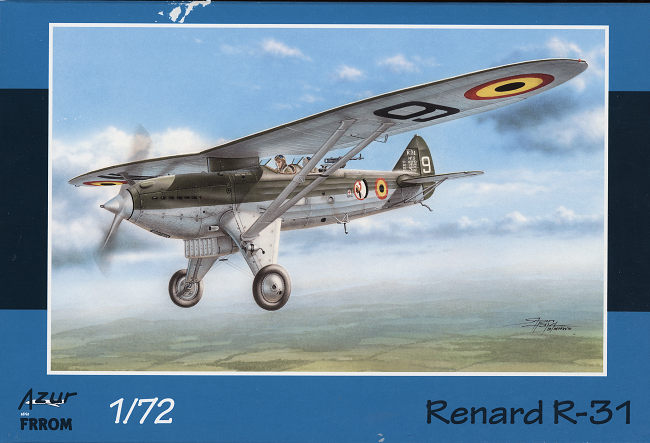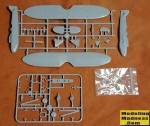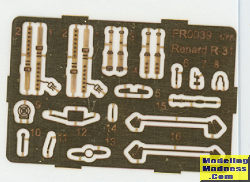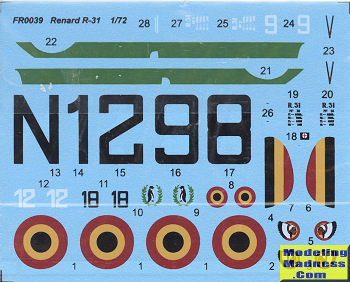
| KIT #: | FR0039 |
| PRICE: | 24 Euros |
| DECALS: | Three options |
| REVIEWER: | Scott Van Aken |
| NOTES: | Includes photo etch fret |

| HISTORY |
The Renard R.31 was designed by Alfred Renard of Constructions Aéronautiques G. Renard to meet a requirement of the Belgian Air Force for a short ranged reconnaissance and army co-operation aircraft. It first flew from Evere Airfield, near Brussels, on 16 October 1932.
It was a parasol monoplane of mixed construction, powered by a Rolls-Royce Kestrel engine, with a welded steel tubing structure with metal sheet covering the forward fuselage and fabric covering of the remainder of the airframe. The wing was held in position by a single Vee strut on each side, conjoined with its fixed under carriage.
An order for 28 R.31s was placed in March 1934, with six to be built by Renard and the remainder by SABCA. One aircraft was fitted with a Lorraine Petrel engine for evaluation, but this was later replaced by the normal Kestrel engine. A second aircraft was fitted with an enclosed canopy and a Gnome-Rhône Mistral Major radial engine, becoming the R-32, with this then being replaced by a Hispano-Suiza 12Y engine, but the R-32 did not show sufficiently improved performance to gain a production order. A further six R.31s were ordered in August 1935.
The R.31 entered service with the Belgian Air Force in 1935, replacing the Breguet 19 in the 9e and 11e Escadrilles d'Observation based at Liège. In service, it was not popular, as it had poor handling, being vulnerable to entering flat spins if mishandled, with all aerobatics therefore being banned.
The R.31 was hopelessly obsolete, and those that were not destroyed on the ground in the early hours of the German Blitzkrieg invasion of Belgium in May 1940 were ravaged by German fighters as they bravely attempted to gather information on the German invasion. None apparently functioned as ground support aircraft during the brief Belgian Army resistance, instead flying fifty-four reconnaissance sorties in support of the Allied forces defending Belgium. Their last sortie, flown on the afternoon of 27 May 1940, was also the final mission flown by the Belgian Air Force in its attempt to repel the Germans. Following the German occupation of Belgium, the Luftwaffe had no interest in the machines and those that had survived the initial onslaught were unused or were destroyed. Overall, these machines had no significant impact on the war although they were briefly involved.
| THE KIT |
 This
is not the first Renard R-31 done in 1/72 scale, but it is the first on in
injected plastic. There are three sprues of which one holds the windscreens and
there is a photo etch fret, which is rather standard stuff from these folks. The
molding is excellent and while there are some of the vestiges of short run, such
as no alignment pins and some ejector stubs inside the larger pieces, it is not
a major issue.
This
is not the first Renard R-31 done in 1/72 scale, but it is the first on in
injected plastic. There are three sprues of which one holds the windscreens and
there is a photo etch fret, which is rather standard stuff from these folks. The
molding is excellent and while there are some of the vestiges of short run, such
as no alignment pins and some ejector stubs inside the larger pieces, it is not
a major issue.
 The photo
etch is well thought out and appropriate consisting of seat harnesses, detail
parts for the rear machine gun, the prop for the generator, boarding step, and
the aileron actuators to name the big bits. The cockpit consists of a floor,
seats rudder pedals, control sticks and instrument panels. Thanks to the nicely
done frame work on the inside of the fuselage halves, the finished interior will
look very convincing.
The photo
etch is well thought out and appropriate consisting of seat harnesses, detail
parts for the rear machine gun, the prop for the generator, boarding step, and
the aileron actuators to name the big bits. The cockpit consists of a floor,
seats rudder pedals, control sticks and instrument panels. Thanks to the nicely
done frame work on the inside of the fuselage halves, the finished interior will
look very convincing.
The main gear legs are quite large and will slot into
the fuselage. Once a spreader bar is installed, then the front and rear sections
of the coolant radiator can be attached. The wing is an upper and lower piece
which fits onto a short pylon atop the forward fuselage of the aircraft. This
makes aligning the wing struts easy. Same pretty well goes for the tailplanes
and their associated struts as there are positive locators for
 both. Note
that you will have to stretch sprue or add wire for the rudder control cables,
the only external wiring on the kit. Building up the rear machine gun is
probably the only really fussy part as so many p.e. bits are required.
both. Note
that you will have to stretch sprue or add wire for the rudder control cables,
the only external wiring on the kit. Building up the rear machine gun is
probably the only really fussy part as so many p.e. bits are required.
Instructions are quite well done and provide detail images and color information using Gunze references. All three markings options are khaki green over aluminum dope. Two of the options are wartime planes from 1940 with the 9th and 11th escadrille. The third option is a pre war plane with the flying school. This one only has the khaki green on the upper fuselage and large green wing chevron on the underside of the wing. It also has the black, yellow, and red rudder stripes of pre-war planes. The decal sheet is very nicely done and should prove to be quite thin.
| CONCLUSIONS |
As these sorts of kits go, this one should be nice build and thanks to the lack of a lot of fiddly bits (well, a general lack of them), would be a good introductory kit to those wanting to give their first multi-media kit a go. It also is a nice addition to parasol wing type aircraft collations.
| REFERENCES |
https://en.wikipedia.org/wiki/Renard_R.31
July 2018 Copyright ModelingMadness.com. All rights reserved. Thanks to Frrom
for the preview kit. You can find this kit at your favorite hobby shop
or on-line retailer. If you would like your product reviewed fairly and fairly quickly, please
contact
the editor or see other details in the
Note to
Contributors.
Back to the Main Page
Back to the Review
Index Page
Back to the Previews Index Page